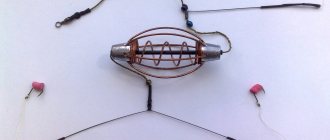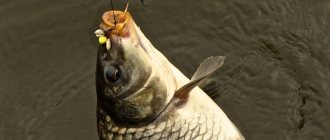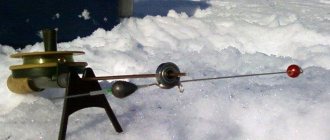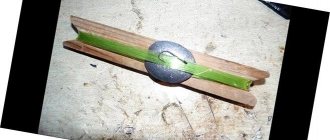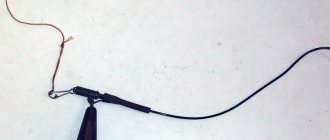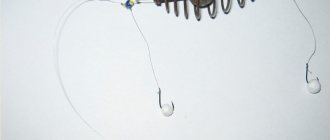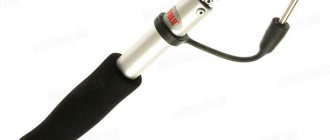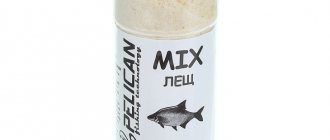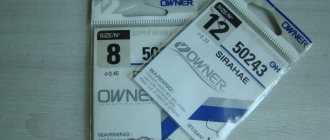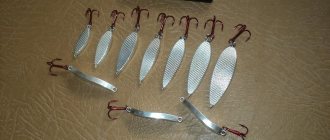Description, features of fish behavior
Crucian carp belongs to the carp family. The genus of crucian carp has a tall body, laterally compressed.
Fish can have two main colors:
- silver;
- golden.
At the same time, crucian carp with a silver color are most common, and golden carp is an artificially bred species. Silver crucian carp is also called oblong, in addition, it has a number of distinctive features from golden crucian carp or, as it is also called, ordinary round carp:
- the color can be gray-green, silver, pinkish-orange;
- pointed muzzle;
- the caudal fin and dorsal fin do not resemble other fins, as they are slightly serrated.
Golden (regular)

Features of common crucian carp:
- golden color (scales cast in gold);
- rounded head;
- smaller size;
- The color of the fins is dark brown.
Peculiarities of crucian carp behavior:
- prefers running water;
- prefers swampy areas with abundant mud;
- found in any water, even cold;
- does not like sandy rocky bottom.
Habitats
Based on geography, several habitat areas for crucian carp can be distinguished:
- Siberia;
- Eastern Europe;
- Central Europe (Central).
By area:
- closed reservoirs;
- pond, small lake;
- quiet backwater of the river;
- peat quarry;
- wetland, such as a forest lake.
Basically, crucian carp lives on the bottom, which is overgrown with algae and has silt. The standard depth reaches 2 m.
Biting calendar by fishing season
Winter season:
- in January and February there is practically no bite;
- in December the bite is average.
Spring season:
- from March to April there is practically no bite, this is due to the fact that spawning begins in April;
- in the second half of May after spawning the bite is very good.
Summer season:
- in June and July the bite is good, but most of the fishing is done with a float rod;
- in the second half of August the fishing season begins with this equipment, including a nipple.
Autumn season:
- in September and October there is a good bite both on bottom tackle and on float-type fishing rods;
- in November there is practically no bite, but this often depends on the characteristics of the reservoir.
The bottom type of fishing is usually attributed to the early autumn period, that is, a bottom fishing rod together with a nipple is used mainly in September-October, but in fact, the bottom type of fishing for crucian carp is more effective than the float method at any time of the year.
Principle of operation
To begin with, you need to immediately accept the fact that there is no specialized nipple exclusively for crucian carp. Many people confuse it with the “crucian carp killer” tackle, but it is more of a kormak than a smaktuha (the second popular name for a nipple).
But this does not mean that it does not catch, it actually works. It's more about choosing the right place. In addition, this tackle has a number of advantages over a conventional feeder when it comes to hard-to-reach fishing spots - grass and snags. Of course, it is impossible to get rid of snags 100%, but reducing the percentage is quite possible.
The principle of operation of the nipple is extremely simple, similar to fishing with a cake. The fish, and in our case crucian carp, swims to a special mastyrka, which is already “packed” into the smaktukha. He sucks it, and he himself does not notice how he sucks in the fatal hook for himself. Whether self-notching will follow depends on the equipment, but this will be discussed in the installation section.
Nipple: features of the gear
The pacifier has several features:
- the possibility of fishing in dense thickets, where it is impossible to use other tackle without a hook;
- Priority for nipples are stagnant bodies of water, since a weak current is desirable for this gear;
- the presence of a feeder, that is, groundbait and bait are located together in the nipple device;
- The nipple, as a tackle, can be used for several types of fish, and at the same time. For example, a nipple prepared for crucian carp may catch carp or bream.
What is a pacifier
By nipple (nipple, sucker, sucker, etc.) professional and amateur fishermen mean a special tackle used for baiting and hooking crucian carp, as well as other bottom-dwelling fish of freshwater bodies. It is one of the varieties of feeder equipment and the so-called “donkey” with some characteristic differences. Its basis is a small, often miniature feeding container, weighted with a load, with several leashes and hooks.
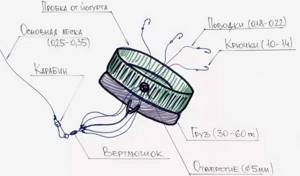
This device works quite simply - the container is filled with bait, into which hooks on leashes are hidden, and then the tackle is thrown into the reservoir. Further, the design works on the principle of a suction bait. Due to the characteristic dragging of food by carp fish, the crucian carp also absorbs a small hook along with complementary foods. After this, the angler just needs to get the fish. This method of fishing makes it possible to achieve a good catch not only simply, but also on almost any body of water.
Did you know? Fishing is considered one of the oldest human activities. It was widespread already during the Paleolithic, and the oldest artifacts date back at least 40 thousand years.
Advantages and disadvantages of gear
Like any device or technical object, a fishing nipple has all sorts of advantages and various disadvantages. They allow us to fully characterize all the features of its application, as well as its feasibility in a particular case. Therefore, not only novice fishermen, but also professionals should definitely get acquainted with this information.
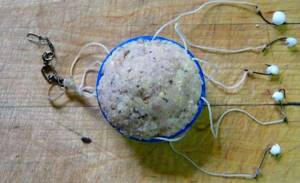
- The undoubted advantages of such equipment are the following:
- high efficiency;
- prostate in use and care;
- the possibility of catching crucian carp in aquatic thickets;
- allows you to successfully catch fish even at night;
- the use of a nipple eliminates the need to pre-feed the fish;
- allows you to catch not only crucian carp, but also other carp and bottom species.
- The pacifier also has some disadvantages:
- not suitable for bodies of water with strong currents;
- it cannot be used in sport fishing;
- the need for additional purchase and installation of a bell;
- the tackle only works at depths of more than 1 m;
- You need bait of the right consistency.
Main varieties
Spring nipple
The first type of nipple is called a spring, this is due to the type of gear, which is similar to a regular spring. Peculiarities:
- most often made independently;
- it is possible to make tackle of different sizes;
- sometimes lead is poured in (during strong currents).
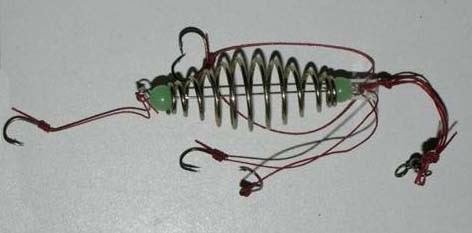
Pacifier plug
This gear has the same function of holding the feeder as a nipple-spring, but it is believed that this type of gear is more effective. Peculiarities:
- non-sports tackle;
- has a self-hooking effect, that is, the fish gets hooked at the slightest movement.

The number of leashes on the nipples is set to 3-5 pieces
There are quite a few types of nipples for crucian carp, but in most cases, fishermen use only the two indicated types, since they are the simplest and most reliable.
Which gear should you prefer?
Fishing with a nipple can be done close to the shore. In this case, a fishing rod with a blind rig can be selected. However, experienced fishermen advise paying attention to the donka for crucian carp with a reel. In this case, you can count on long-distance casting of tasty treats in the form of bait. As for the fishing rod, it can be anything. It is desirable that the element be compact, but at the same time dense. Everything else is not significant.
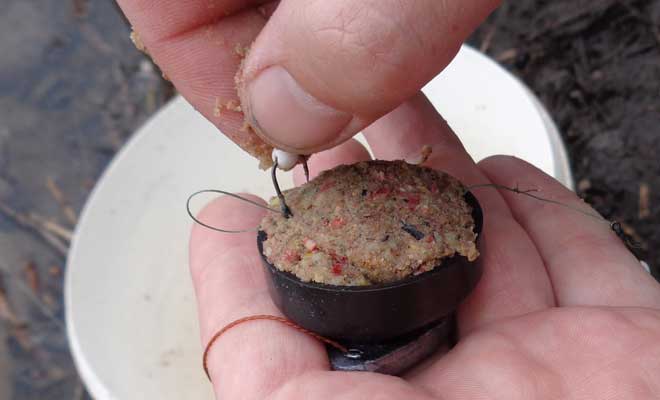
There are fishermen who, using a nipple for crucian carp, use a monolithic spinning rod, the length of which is about 1.5 meters. However, if possible, it is better to take a telescopic fishing rod made of fiberglass, the size of which is from two meters with dough to forty grams. Due to the long whip, it will be possible to make a longer cast.
Important! If a fisherman wants to fish further from the shore, then he cannot do without a rod more than three meters long.
Speaking about the coil, it is worth noting that you can use any one at your own discretion. If you decide to use inertial, then it is advisable to choose a rotary one.
In cases where there is a possibility that carp may start to bite, it is recommended to stock up on a large and powerful reel.
If we talk about the main line, it can be either braided or monofilament. Usually fishermen do not take more than 50 meters. As for the diameter of the element, you can safely take products with a cross section of 0.2-0.3 mm. Braided fishing line has higher sensitivity, but it also costs more.
As a bite alarm, you can use either an electronic special alarm or a bell.
Structural elements
Fasteners
The bait is attached to the feeder using a nipple, which should be:
- weighing from 20 to 50 g;
- concave container (for example, it can be made from a regular plastic lid or small plate).
To make a pacifier you may need:
- small drill with a set of drills;
- thin nail;
- small bead;
- pliers;
- copper or brass pieces of wire with a cross-section of 1-2 mm;
- soldering iron;
- a metal sheet with dimensions of 4x3 cm, while the metal can be different (lead, brass, copper, steel).
Sinker
Most often, lead pieces are used as a sinker, less often small nuts. The choice of sinker should take into account the following features:
- current strength;
- required depth;
- presence of thickets.
Leash with hooks
The leash on which the hook is attached has a rope base, which differs from a simple rope in a number of properties:
- the desired material is wicker;
- the length of each leash varies from ten to twenty centimeters;
- the magnitude of the breaking force is strictly more than two kilograms;
- hooks can be used from numbers six to ten (selected according to the bait).
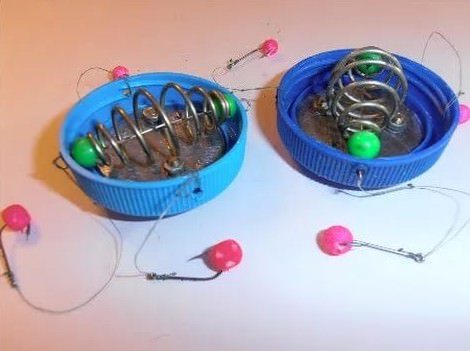
Modernized pacifier
fishing line
The choice of fishing line is determined by the local characteristics of the reservoir. The standard size is a piece of fifty meters, while the thickness of the fishing line fiber is two tenths of a millimeter. There may be restrictions on the fishing line:
- the maximum length of forest fiber is 200 meters;
- the fishing line must have a maximum diametrical cross-section of 0.6 mm.
Coil
Most often, a spinning reel is used, which differs only in size. Coil limits range from 2.5 to 3.5. In principle, any reel can work. Fishermen use an inertial-type reel or usually a “meat grinder”.
Rod
The basis is a regular fishing rod, but fishing for crucian carp has its own characteristics:
- It is advisable to use a telescopic type fishing rod;
- fiberglass would be the best choice for the material;
- length size from 2 to 2.7 m;
- the desired test should be at least 40 grams.
Tackle and all its components
To fish for crucian carp, you will need a regular fiberglass telescopic rod with a length of 2.1-2.7 m. The test rod should be at least 40 g.
It is best to purchase a spinning reel 50 m of monofilament fishing line with a diameter of 0.2-0.25 mm on the spool
The leashes are made from pieces of braid 10-20 cm long with a breaking force of 2 kg.
Hooks are used depending on the bait in the range of No. 6-10.
The pacifier is a feeder weighing 20-50 g. It can be made of wire in the form of a spring, in the form of a concave lead or brass plate, or from the cork of a plastic bottle.
An ordinary bell or an electronic device becomes a bite alarm
Advantages and disadvantages of gear
pros
The tackle has several positive aspects:
- the nipple will not get caught on an uneven bottom;
- you can fish in thickets of any density;
- the tackle practically cannot get tangled;
- With the correct design, leashes with hooks will not dangle, unlike other bottom gear.
Minuses
It is believed that this type of gear has no disadvantages, but there are a number of negative features:
- this type of fishing is not sport;
- in very strong currents the tackle is ineffective.
Gear design and its varieties
The nipple itself for crucian carp is a simple device; it is used to throw a feeder with a large volume onto the place where the crucian carp is caught; dough-like feeding should be pushed into the feeder itself.
In this method of fishing, the bait is also the bait. The crucian carp are attracted by the smell of the bait, begin to suck on the feeder and are caught on hooks hidden in the bait. Today there are many different options for pacifier designs. Let's consider the two most commonly used designs of this equipment:
- - often fishermen use a nipple, which consists of a spring feeder; in this feeder, the sinker itself is located from the inside, to which fishing line material with several leashes and hooks is attached; in shallow water areas, crucian carp can be caught without a load; feed is stuffed into the spring itself, and into the feeder itself. feeding is hidden by hooks;
- — fishermen also often use a pacifier-plug, it is made from a regular cork from plastic bottles or shampoo bottles, a disk or lead plate is attached to the upper surface of this cork, holes are made on the sides of the cork itself, through which the main fishing line is attached and leashes with hooks;
- - you can use the pacifier option from a regular spoon, the handle breaks off, small holes should be made along the entire perimeter of this spoon, to which the main fishing line material, as well as leashes and hooks will be attached, in addition, you should pass the wire through the holes and make, as it were, a dome of wire over the spoon so that the feeding sticks better on the spoon itself; the spoon is also stuffed with complementary food, in which the hooks should be hidden.
Experienced fishermen know that there are a great variety of nipples. True, the principle of operation they do not differ from each other. The tackle consists of a feeder, a couple of leashes and is used only at the bottom. Plug nipple and spring nipple are the most popular options that anglers pay attention to.
Below we will describe in detail both one option and the other.
Spring nipple
This product is a tackle where the role of a feeder is played by a spiral or spring made of metal. There is a weight inside the element. It is the part to which the fishing line, leashes and hooks are attached. If fishing with a nipple is carried out at shallow depths, then it is permissible not to use a weight.
In this case, some fishermen use a “donut”, which is a spring and has the shape of a steering wheel, and leashes with hooks are attached to it. Fish treats are placed in the center of the donut where the hooks are. Thus, tasting something tasty, the fish gets hooked.
Pacifier plug
Equipment in the form of a cork appeared not so long ago. It consists of a plastic bottle (citro or yogurt), and a lead disk is attached to its upper part using a bolt, nut or wire.
In addition, there are also a couple of holes on the side circumference, where through one the feeder is attached to the main fishing line, and on the others there are leashes with hooks. As for filling the feed, everything happens in the same way as in the previous case. The treat is in the middle of the feeder, where there are hidden hooks. Sometimes fishermen boast that self-hooking happens. This doesn't happen often, but it does happen.
Making your own pacifiers
Materials
Spoon nipples
For pacifiers, these improvised means are used:
- spring;
- cork;
- spoon;
- metal plate (preferably brass);
- small plastic cup.
To make your own “nipple” type tackle, you need this list of materials:
- any cork container, for example from a bottle;
- a small lead sinker;
- swivel device;
- small bead;
- 4 leashes, each with a hook.
Build process
To assemble the pacifier you will need to follow a strict manufacturing plan:
- We attach a lead sinker to the cork bottom. The diameter of the sinker is equal to the cork. The fastening is created using a self-tapping screw, and the excess is cut off.
- The cork sides have four drilled holes.
- A leash with a length of up to sixty millimeters is attached to each hole. A hook is tied to the end of the fishing line fiber, after which ten centimeters of fishing line must be cut off. At the end of the leash without a hook, a loop is created, and the total length should be no more than six centimeters. The loop needs to be threaded through the plug hole, while the hook passes through the leash loop and the leash itself is tightened. This needs to be done with each leash.
- The cork bottom must be drilled using a thin drill, which is smaller in diameter than the bead. After this, a fishing line passes through the hole and a bead is put on. To prevent the bead from falling off, the end of the fishing line has a knotted triple fastening;
- It is necessary to cut about 40 cm from the main fishing line fiber, so we get a leash that ends with a cork.
- A swivel must be attached to the free end of the cut line.
- After attaching the main line to the swivel, the tackle is considered ready.
How to make a cork for crucian carp with your own hands
Many fishermen want to know how to make a nipple. The reason for this is that the tackle is simple, convenient, and does not require any special knowledge in fishing. In addition, in general, in terms of money, if you do it yourself, it will not be expensive.
To make it you will need to stock up on the following parts:
- A traffic jam.
- Nails or drill.
- Scissors that cut metal.
- Wire (medium wire will do).
- A sheet of lead or a metal coin.
- Winding ring.
Next, you will need to use scissors to cut out a round weight, which is the same size as the size of the cork. If sheet lead is not found for this purpose, then a metal washer will also work. After this, two holes should be made in the cargo, as well as in the cork, using a drill or nail. Next, you will need to attach the load with wire. It is important to ensure that the twist is inside the cork. Then you need to make a couple of holes in the side circumference of the cork. Place the winding ring in one and attach it. It is through this element that the feeder will be connected to the fishing line. You will need to attach leashes in the main holes. Some people make them from braided fishing line.
Important! It is best to use braid, which has a breaking load of 2 kg. This will be quite enough, besides, such a fishing line is soft and works great when fishing.
Bait selection criteria
Ingredients
The same products are usually used for complementary foods and baits.
As ingredients, you can use any plant mixture that is diluted with a chicken egg. For regular bait for crucian carp you need:
- wheat, rye, corn flour, each 100 grams;
- 100 grams of ground cake;
- 200 grams of dry bread, minced;
- 2 chicken eggs.
Availability of flavors
There are two types of flavorings:
- purchased (special);
- homemade (from scrap materials).
Different flavors are used for bait and bait, but both types are used in the nipple. Thus, a pacifier flavor is most often used to simply attract crucian carp, that is, a special flavor is bought in the store that will only attract crucian carp.
It is worth remembering that flavoring substances vary in consistency:
- oil;
- spray;
- syrup;
- dry powder;
- liquid.
All of these types, when used, must be added during the preparation of the bait. If desired, you can use homemade substitutes:
- berry juice;
- vanillin;
- ground nut;
- cocoa;
- dried herbs;
- fresh animal blood;
- dried insects;
- finely chopped worms.
Equipment with pacifier
There are 2 main types of pacifier attachments; sliding and deaf. Their main difference is that the sliding equipment is not tightly attached to the fishing line, but has free movement along it, allowing the fish to leave with the bait without encountering resistance from the weight of the equipment.
The principle of their design:
1. Sliding
Spring nipple:
- The main line is threaded through the central rod of the spring.
- A bead is put on the fishing line.
- A triple knot is made on the fishing line.
- 4 leashes, up to 6 centimeters long, are attached to the triple knot.
The spring is filled with bait, it has 4 nipples, and hooks are hidden in them, with the forearm inward and the sting outward.
The fish, approaching the bait, begins to suck on it and sucks in the hook. Having bitten off part of the bait with it, the fish swims to the side, dragging the fishing line with it without equipment. Without feeling the resistance of the weight of the equipment, the fish is not afraid and does not try to get rid of the bait, thereby increasing the likelihood of being hooked.
A similar type of equipment can be made from any material used to construct the nipple.
READ MAJOR CRAFT ZONER MINNOW 110 SP
Deaf
Cork nipple:
- Five holes are made in the cork.
- Leashes with hooks are attached to 4.
- The main line is attached to the 5th.
The cork is clogged with bait, and hooks are hidden in it. The tackle is thrown into the pond. The fish, starting to suck the bait, sucks in the hook. Swimming away from the bait, she feels the resistance of the weight of the tackle, gets scared, makes a sharp jerk to the side, and the fish hooks itself.
Recipes
The standard method of preparing pacifier basket filling has a fairly simple recipe.
This requires:
- Boil the corn kernels, then crush them to a mushy consistency.
- Add flavoring to the porridge (if desired).
- Add 200 grams of rye flour, while mixing thoroughly.
- If the dough becomes too thick, add water.
- The dough is divided in half and placed in two plastic bags, which must then be tightly tied.
- Each package is placed in boiling water and cooked for twenty minutes.
- The package is taken out, unfolded, and the dough cools down.
- After the dough has cooled, it is put into new bags, which are tied so that the dough consistency does not dry out.
A similar composition of nozzle or bait can be bought at a fishing store, but when making it with one’s own hands, the fisherman is guided by the characteristics of the reservoir, which leads to greater efficiency.
Lure
There are even more varieties of bait used when catching crucian carp using the nipple. They are mostly made by fishermen themselves, and those bought in specialized stores must be supplemented with the necessary components, depending on the preferences of the fish in a given body of water.
The difference from bait, which is used in feeder fishing, is that for the “nipple” the consistency of the bait should be more viscous. If the bait from the feeder feeder must be washed out relatively quickly in order to attract fish from a long distance and keep it at the selected point, then with the “nipple” it is somewhat different.
A strong aroma (anise, garlic) works mainly to attract fish. The bait itself must stay in the feeder long enough for the crucian carp to come up and start sucking on it.
The so-called fishing clay is best suited for these purposes. It is made as follows:
- Boiled 200 gr. Grind corn kernels in a blender.
- Add 200 gr. rye flour and mix thoroughly.
- Add water if necessary to prevent the dough from thickening too much.
- Divide the resulting mass into two plastic bags.
- Place the bags in boiling water and cook for 20-25 minutes.
- Take out the bags and open them to let the dough cool.
- Transfer the dough into clean bags and tie it tightly so that it does not become airy or dry out.
The attractant can be added at any stage. The main thing is that it is evenly distributed throughout the entire mass of bait.
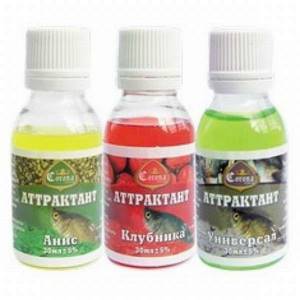
In spring, crucian carp prefers pungent odors. In summer - sweets Cooking semolina for crucian carp (video)
Another option for bait with semolina:
- Gently pour semolina into boiling water, stirring constantly.
- Continuously stirring, bring the mixture to a homogeneous consistency.
- After this, the container with the resulting dough must be wrapped and allowed to brew for half an hour.
- An attractant is added to the cooled mass.
- The resulting bait should be placed in a plastic bag and tied tightly.
Bait is also made from:
- Boiled potatoes.
- Breadcrumbs.
- Oatmeal.
- Steamed millet.
In addition to flavoring, it is recommended to add a raw chicken egg to these mixtures for binding.
Equipment installation options
sliding
Installation of equipment can be sliding or blind. Creating a sliding option:
- take a spring or cover loaded with bait;
- a loop is created at the end of a fishing line 80 cm long;
- a flavor stopper made of a silicone base and a spring equipped with a tube are attached;
- a swivel device having a clasp is attached to the end;
- using a knot fastening (loop to loop), a leash with a hook is attached;
- with the help of a carbine it is attached to the main line fiber.
Deaf
The installation system of the blind version of the equipment is simpler. It is created this way:
- 3-5 leads are attached to a spring or plate;
- the feeder is attached to the main fishing line fiber using a large loop;
- The nipple is stuffed with viscous bait in which the hooks are hidden.
The principle of pacifier fishing
First you need to find a place to feed, after which the nipple is filled with porridge, bait is attached to the hooks and the tackle is thrown into the water.
The fish swims up to the nipple and begins to taste the food. As a result, along with the food, there will be hooks in her mouth. Yes, before casting, the baited hooks are hidden in the mush. This makes it possible for the leashes not to overlap during casting. Once in the water and falling to the bottom, the hooks begin to release, luring additional crucian carp.
Features of the killer nipple for crucian carp
The killer nipple is a special type of bottom fishing tackle and fully lives up to its name. This gear has better catch characteristics than simple nipples.
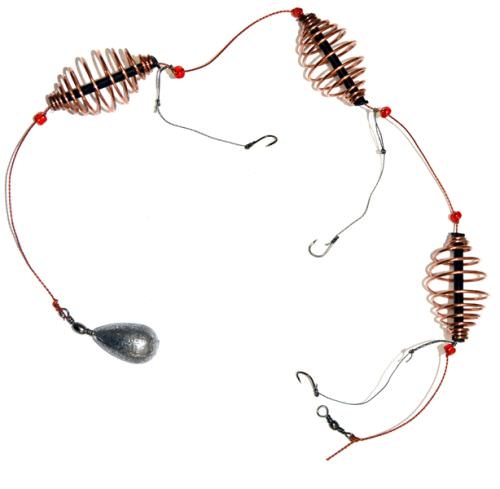
- the tackle has several spring feeders, the maximum number of which can reach 4;
- each spring has a short leash with a hook on which a scented foam ball is baited;
- a load is attached below the equipment, and a spring device above;
- each spring is stuffed with viscous bait, for example, porridge;
- The rod can be any spinning tackle. There are restrictions only on the diametrical cross-section of the forest fiber, which can be a maximum of 0.5 mm.
How to catch crucian carp on a nipple
The process of catching fish such as crucian carp using a nipple is quite simple and will not cause any difficulties even for beginners. The feeder is filled with complementary food, which should be doughy and thick; the hooks should be pressed inside this complementary food.
Next, you should carry out the process of throwing the feeder to the place where the crucian carp are supposed to be located. The feeding itself begins to emit aromas favorable for crucian carp, which quickly spread throughout the reservoir, the crucian carp, having smelled the food, swims up and begins to suck on the feeder, drawing in the feeding, at the same time the hooks are swallowed, that is, the fish itself carries out the process of hooking itself.
For this type of fishing, any fishing rod that is available will be appropriate. It is best to take a short fiberglass spinning rod; its weight does not play any role, since it will always be located on stands. Attention should be paid only to power and dimensions.
For some anglers, fishing for crucian carp on a nipple is attractive not only because of the low cost of all fishing accessories. For example, they use the same spinning rod to catch pike during winter fishing, re-equipping it in the summer for smokefishing. Nipple fishing is considered a slow fishing method, so it is preferred by lovers of slow fishing.
It is possible to put any suitable reel on the rod - from a Nevskaya and a multiplier to a spinning reel. Monofilament with a cross section of 2-3 mm is suitable as a central line, but preference should be given to braided line, which, due to its extremely low elongation, is more sensitive to bites.
If you decide to put a multiplier reel on the rod, then the section of the line does not play a special role, since the casting range will not be affected; on other types of reels, you should not get carried away with thick line. What you definitely don’t need to skimp on is hooks. Good and sharp stings greatly contribute to the self-hooking of fish.
Having threaded the line through the guide rings of the rod, we attach a swivel with a clasp to it, which, due to the large weight of the nipples, must be quite strong. We snap the equipped feeder onto the clasp. By the way, it is very convenient to have several smoktukhs ready for casting in the shade, so that after recasting you do not waste time stuffing the porridge and disguising the hooks.
The size of the hook is chosen based on the ability of the fish to calmly suck it in without sensing danger and get hooked. At the same time, too small one is unlikely to hold a large fish. The optimal hook should have a sharp tip and a short shank so as not to get stuck in the stern. To increase buoyancy, a piece of foam is strung on it.
After casting the rig, the rod is placed on stands. If the tip of the form acts as a bite indicator, then the slack in the line is removed. It is possible to use a bell or a regular clothespin as a signaling device.
Whatever the best nipple for crucian carp is at the other end of the line, you can’t do without a bite indicator. The good thing about a bell is that it allows you to be distracted by other things or gear. Although there is a category of fishermen who are opponents of bells, citing their immunity to small fish pokes.
In fact, this is the most acceptable signaling device, which can be installed both on the form and on the forest itself using a clothespin. A simply purchased bell can be adjusted, and it can be adjusted so finely that it will respond even to the blow of a breeze. It's all about the antennae, which compress or extend - that's the whole adjustment.
We suggest you read: How to tie a float to a fishing line in various ways
If you are using a nipple plug to catch crucian carp, you should never rush to hook it. Sluggish movements of the bite indicator may indicate that the fish are beginning to eat the porridge. It is necessary to react when the tip of the rod begins to sharply bow to the pond or the bell screams heart-rendingly.
Hooking is done in two ways, depending on the fishing distance, and also if there is a nipple for crucian carp in the current. If a monofilament line is wound on a reel, it tends to stretch, and over long distances and strong currents, the degree of stretch can reach twenty percent.
In case of a bite, you need to quickly grab the rod and at the same time swing back, you should move away a couple of steps, working with the reel. It is much easier to hook a fish if the distance does not exceed thirty meters. Here, an upward swing will be enough to pierce the flesh of the fish.

If we talk about the seasons, then the most productive time for catching crucian carp is in the spring. Warm, fine days come, the crucian carp loses its former lethargy and begins to actively fatten. The bite becomes greedy and lively.
Fishing for crucian carp on the nipple in May is marked by spawning, and at this time the fish are easy to spot in the shallows. Often from the reed thickets you can hear chomping sounds characteristic of grazing crucian carp. Unfortunately, when there is an abundance of fish in a reservoir, there is a complete lack of bites.
In principle, crucian carp begin to fish in the spring from mid-April, when the ice melts and the reservoir begins to warm up. Shallow water areas near the reeds, where dragonfly larvae emerge from the bottom soil, are considered promising places at this time of year. Large individuals are located near flooded snags and trees.
Fishing with a nipple can be done close to the shore. In this case, a fishing rod with a blind rig can be selected. However, experienced fishermen advise paying attention to the donka for crucian carp with a reel. In this case, you can count on long-distance casting of tasty treats in the form of bait. As for the fishing rod, it can be anything. It is desirable that the element be compact, but at the same time dense. Everything else is not significant.
There are fishermen who, using a nipple for crucian carp, use a monolithic spinning rod, the length of which is about 1.5 meters. However, if possible, it is better to take a telescopic fishing rod made of fiberglass, the size of which is from two meters with dough to forty grams. Due to the long whip, it will be possible to make a longer cast.
Speaking about the coil, it is worth noting that you can use any one at your own discretion. If you decide to use inertial, then it is advisable to choose a rotary one.
In cases where there is a possibility that carp may start to bite, it is recommended to stock up on a large and powerful reel.
If we talk about the main line, it can be either braided or monofilament. Usually fishermen do not take more than 50 meters. As for the diameter of the element, you can safely take products with a cross section of 0.2-0.3 mm. Braided fishing line has higher sensitivity, but it also costs more.
As a bite alarm, you can use either an electronic special alarm or a bell.
The nipple for catching crucian carp can be used in coastal thickets, on the boundaries of holes, near the edges, as well as in areas where there are sharp changes in depth. In order to know exactly where to fish, you should use a stepped spinning line, a marker float or an echo sounder.
As for the fishing technique, everything is extremely simple. First you need to pour food into the nipple. Leashes with hooks will be hidden in the bait. When everything is ready, the tackle can be thrown into the water. The product lies on the bottom and the delicacy is gradually washed out of it. A fish swims nearby, hears a pleasant smell, and then begins to try the food offered to it, swallowing the hook along with it. At this moment, the signaling device informs the fisherman that the catch has been caught and can be pulled out. Everything works extremely simply.
The nipple is a fishing tackle that all fishermen who come to fish for crucian carp can try to use. Making tackle is very simple, and fishing with it is even easier. If you do everything correctly, you can catch not only crucian carp, but also roach, bream, carp and many others.
The sliding version of the equipment is used when using a spring as a feeder. A loop is made on a piece of fishing line 70-80 cm long. Then a silicone stopper-shock absorber and a spring equipped with a PVC tube inside are mounted. A swivel with a clasp is attached to the end of the rig. Now all that remains is to attach the leash with the hook in a loop-to-loop manner, and attach the equipment to the main fishing line using a carabiner.
Blind equipment is made as follows. Leads (3-5 pieces) are attached to the spring, plate or plug. The feeder is mounted on the main line thanks to a large loop on the main line. Viscous bait is stuffed into the nipple, into which the hooks are hidden.
First, the feeder is filled, after which it becomes like a ball. Then hooks are inserted into the bait (necessarily with the tip facing out) and also covered with the mixture. It’s also worth hiding the leashes, otherwise they will alarm the timid crucian carp. The rig, ready for casting, resembles a pine cone with protruding tubercles, convenient for suction, with hooks hidden inside. You can leave one outside with a maggot, worm or small foam ball on it.
Anglers often argue about what to bait when fishing with a nipple. Some say that it’s nothing at all, they say, crucian carp sucks even bare hooks very well. Others insist that attractive wildlife or at least foam balls are needed to provide buoyancy. Perhaps the latter are right. The foam will really keep the hook afloat, that is, right in front of the crucian carp’s nose. A few minutes, and he is already in the fish's mouth.
So, we fill the feeder, stuff the hooks with food, throw it in and wait for the crucian carp to approach. There is no need to explain what to do after a bite. This is how the insidious and at the same time simple pacifier works.
Fishing technique and tactics
Catching crucian carp using a nipple has a specific technique, which consists of several important points:
- There should be small bells on the rods, as the bite can be missed. Often the crucian carp bites almost unnoticed.
- A nipple is often used in night fishing, which becomes very simple with a bell.
- In one body of water, it is advisable to use several fishing rods; this is required for the reason that crucian carp can gather in one place (for example, someone fed them). Thus, there is a greater chance of finding a congestion site.
- Fishing in a reservoir with a depth of less than a meter is pointless, since the tackle does not work at such a depth.
- This type of fishing does not require baiting crucian carp. At the same time, the consistency in the feeder itself can be made more attractive with the help of vanilla sugar.
- When preparing a regular dough, it is prepared immediately before the fishing process itself.
- The consistency of the dough should be soft, but not sticky.
- The feeder is filled with the test mixture so that all the hooks are securely hidden.
- This fishing method is suitable not only for crucian carp; you can also catch carp and roach.
Technique for catching crucian carp with a nipple
How to insert foam hooks into pacifiers
- The cork is tightly filled with viscous food with a mound.
- Hooks with foam plastic are inserted into the food (ears down, bend up).
- You can throw the pacifier into the most inaccessible places with tall vegetation and not be afraid that it will get caught. After all, there are no open hooks in the tackle.
- The number of bites depends on the number of crucian carp interested in food. One thing is clear, any crucian carp will like the recipes described above. But the crucian carp needs time to first find the nipple, taste it and only then grab the hook.
Tips and tricks
For catching crucian carp using a device such as a nipple, there are a number of recommendations that are useful for all fishermen to know:
- It is advisable to make the leash braided, and the braid is made from forest fiber. This is necessary so that the crucian carp does not become wary when contacting the leash, and the softness of the fishing line allows this.
- It is recommended to use swivels with a carabiner mechanism, as this eliminates the main line from twisting and also speeds up the installation and dismantling processes with the feeder.
- The magnitude of the breaking force of braids and leashes should be less than that of the main fishing line fiber; this is required so that in case of dead hooks the hook is lost, and the equipment remains on the main fiber.
- Plate nipple
Each hook that is used in the design of the tackle must be sharp and durable. - To make it easier to attach leashes to plastic plugs, winding rings are used.
- For the pacifier-spring, brass or copper wire is used, since with this material the work is more convenient, and in addition, there is no rust.
- To make and use a nipple, in the absence of a complete set of materials, a simple fishing rod with a fishing line, at the end of which there is a nipple device, can be used.
- The best option for fishing is the killer nipple, as this type of nipple is the most effective.
- To increase the effectiveness of biting, you can use commercial bait with a pheromone base.
- Any dough that is made as bait or bait must contain a worm, maggot, or bloodworm, since the presence of these ingredients greatly increases the likelihood of a bite.
- Before you start making a homemade nipple, you need to look at the features of the reservoir in which crucian carp will be caught. This is due to the fact that each body of water has different depths, current strength, and the presence of vegetation.
- If there is a current in the reservoir, then it is advisable to increase the mass of the sinker, but with the condition that the nipple device does not sink deep into the silt. This is required for the bait to work, and the silt will block the smell of the contents of the feeder.
- The best time for fishing with a nipple is the end of May, when the crucian carp has a post-spawning feast, and also in September-October before the onset of cold weather.
Although the method of bottom fishing for crucian carp is considered effective at any time of the year, with the exception of spawning and icing of the reservoir, during which crucian carp lead a sedentary lifestyle. - For fishing, each angler must have with him several types of baits, which are created from different test consistencies. This requirement is determined by the fact that crucian carp will not bite on some type of bait, while any bait in the nipple can be replaced.
Spoon pacifier
There are fishermen who make tackle from an ordinary spoon. True, it is undesirable to use tin or aluminum for these purposes. The ideal option would be cupronickel or stainless steel spoons.
Having found a suitable option, you will need to cut off the handle, sand the cut area so that there is not even the slightest hint of roughness, and then drill several holes around the perimeter of the product so that they are located a couple of centimeters from the edge. As in the previous case, the main fishing line is attached to one hole.
Experienced people advise not to tie more than three hooks on a nipple made from a spoon, because otherwise the leashes begin to get tangled with each other, which prevents a good bite. The presented product has a lot of advantages, the main one of which is an excellent casting range and great weight, which makes it possible to forget about additional weights.
It is possible to make a similar feeder from an ordinary tablespoon. True, its mass must be sufficient, so aluminum will not work. Making a nipple for crucian carp begins with sawing off the handle flush; the cut area is carefully processed with a file and polished.
We invite you to familiarize yourself with: Jig rigs, non-hooking, movable and rigid rigs
Five holes are made along the edges of the spoon, retreating a few millimeters. All are polished to smooth out any sharp edges. The hole in the top of the spoon, where the handle once was, is intended to secure the carabiner and swivel to which the central line is tied. A wire is passed across the remaining four holes and twisted on the outside. It serves for better retention of bait.
If the wire is of small cross-section, you can make two turns, and tin the ends and grab them with a soldering iron. Before you prepare a nipple for crucian carp, you should remember that light spoons will not work; cutlery made of heavy stainless metal or cupronickel is most appropriate. By the way, a silver spoon has proven itself well.
Such equipment is sometimes called a crucian killer nipple, but this is not an entirely correct judgment; there are fundamental differences between these equipment. But why the spoon is preferred is its excellent aerodynamic parameters, which allow it to be thrown over considerable distances.
What other advantages does the spoon form have:
- The leashes are mounted to the loops rather than through the holes, which allows them to be transported separately without the risk of tangling.
- The leader can be easily replaced when the hook tip becomes dull.
- You can change the number of hooks depending on the biting activity.
- When removing the feeder, the leashes get tangled much less often than with the same spring.
- Thanks to its shape, the spoon sinks to the bottom correctly, leaving the bait untouched, and no matter how many leashes the nipple has, all the hooks will be positioned correctly.
- When extracted from the water, due to the aerodynamic shape, the resistance is minimal, which plays an important role when a large fish is sitting on the hook.
This nipple for crucian carp does not require any material costs and is easy to make at home. In addition, with other forms of feeders, although it is rare, snags do occur if fishing is carried out in a reservoir overgrown with vegetation; with a spoon it is almost impossible to catch on an obstacle.
There are also very simple options for making fishing gear, somewhat similar to a crucian killer. You can fish with such equipment throughout the open water of a reservoir, and their production requires minimal cost and time.
Fishing for crucian carp using a nipple made from the cap of a plastic bottle or other container is no different from the method described above. There are several manufacturing options, we described one of them in the article “Fishing with a nipple: from small things to a trophy.” Let's talk about one more thing.
- A lid from a plastic canister is suitable for making. A lead circle weighing 35-55 grams is machined according to its size. One hole is drilled in the bottom and lid and lead weight if the fastening is screw, or two to connect the elements with wire. The presence of a load is mandatory, otherwise the immersion of the nipple will become unpredictable.
- 3-4 holes are pierced along the perimeter of the lid at equal distances. Through one of them the central line is mounted using a swivel and an anti-twist; leashes 10 centimeters long with very sharp hooks are tied to the remaining holes.
- You can also insert winding rings or homemade ones from wire into the holes and knit leashes directly to them. If the rings are made of wire, cambrics are threaded through them to prevent abrasion of the leash.
A cork teat for crucian carp can be replaced with a spring tackle. A factory spring with a tube along the axis is suitable for this. In this case, you can make inline equipment, when the scaffolding is threaded into the tube. The free movement of the feeder is limited by stoppers.
A swivel with a carbine is mounted at the end of the scaffolding. One of the leashes is tied to it, the rest are tied to a ring, which is fixed next to the stopper. With this method, you can limit yourself to blind equipment.
